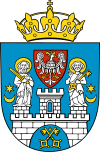Poznan, Poland
| Poznań | |||
|---|---|---|---|
| Capital City of Poznań Stołeczne Miasto Poznań |
|||

Top: Panorama of Poznań City Center
Middle: Poznań Town Hall, Stary Browar, Opera House Bottom: Guardhouse |
|||
|
|||
| Coordinates: 52°24′N 16°55′E / 52.400°N 16.917°ECoordinates: 52°24′N 16°55′E / 52.400°N 16.917°E | |||
| Country | Poland | ||
| Voivodeship | Greater Poland | ||
| County | city county | ||
| Established | 10th century | ||
| Town rights | 1253 | ||
| Government | |||
| • Mayor | Jacek Jaśkowiak | ||
| Area | |||
| • City | 261.85 km2 (101.10 sq mi) | ||
| Highest elevation | 154 m (505 ft) | ||
| Lowest elevation | 60 m (200 ft) | ||
| Population (31 December 2010) | |||
| • City | 551,627 | ||
| • Density | 2,100/km2 (5,500/sq mi) | ||
| • Urban | 1.1 million | ||
| • Metro | 1.4 million | ||
| Time zone | CET (UTC+1) | ||
| • Summer (DST) | CEST (UTC+2) | ||
| Postal code | 60-001 to 61–890 | ||
| Area code(s) | +48 61 | ||
| Car plates | PO | ||
| Website | http://www.poznan.pl/ | ||
Poznań ([ˈpɔznaɲ]; German: Posen, known also by other historical names) is a city on the Warta river in west-central Poland, in the Greater Poland region. It is best known for its renaissance Old Town, destroyed during World War II and then rebuilt, and Ostrów Tumski Cathedral. Today, Poznań is an important cultural and business centre and one of Poland's most populous regions with many regional customs such as Jarmark Świętojański, traditional Saint Martin's croissants and a local dialect.
Poznań is among the oldest cities in Poland. It was one of the most important centres in the early Polish state in the tenth and eleventh centuries. Initially the city was based on Ostrów Tumski, a natural island on the Warta river-very similar to the Île de la Cité in Paris. The first rulers were buried in the nearby cathedral, which is one of the oldest Christian temples in the country. Poznań also served as the capital of Poland (for a short time) in the 13th century, hence the official name - "The capital city of Poznań". After the second partition of Poland Poznań was administered by Prussia, and then, with the unification of Germany after the Franco-Prussian War of 1871, the province of Posen became part of the German Empire. Furthermore, the city of Posen was officially proclaimed a residential city of the Kaiser, leading to the construction of the Imperial Castle, the Imperial District, the Opera House, new city walls, railway station and many other sites which make a big part of its landmarks to this day.
...
Wikipedia



